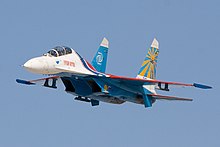Airplane

Anairplane,also known as anaeroplaneor justplane,is afixed-wing aircraft.It moves bythrustfrom ajet engine,propeller,orrocket engine.Airplanes come in many shapes and sizes. The use of aircraft is calledaviation.Airplanes are used for many things includingrecreation,transportation of goods and people,military,andresearch.
They can move much faster than road, rail or sea transport, and so they are often the choice for long distances. Many long distance airplanes are bigger than others because they need to carry more fuel.
Commercial aviationtransports more than four billion passengers annually onairliners.Cargo aircraftcarry more than 200 billiontonkilometresof cargo every year, which is less than 1% of the world's cargo movement. Most airplanes are flown by apiloton board theaircraft,but some are airplanes made to beremotely or computer-controlledsuch asdrones.
Airplanes fly between many cities all over the world, carrying people andcargo.Big cities usually have aninternationalairport,where large airplanes can land and take off safely. Some large cities likeNew York CityandLondonhave more than one airport. Two major makers of airplanes areAirbusandBoeing.
Statisticsshow that riding in a plane is safer than driving in a car.[1]
Food[change|change source]
People make jokes aboutairlinefood, because they say it tastes bad.[2]While travelling on anairlinerat a high altitude, it can cause dryness. Because of the low pressure, a person'staste budsare around 30% less sensitive to sweet and salty foods.[2]
Wings[change|change source]

The wings of a fixed-wing aircraft are static planes extending either side of theaircraft.When theaircrafttravels forwards,airflows over thewings,which are shaped to create lift. This shape is called anairfoiland is shaped like abird's wing.
Uses[change|change source]
Transport[change|change source]
Fixed-wing aircraft have long been used asairliners for movingpassengers from place to place.Cargo aircraftcarrycargoacross seas and long distances, and passenger aircraft also carry some cargo.
War[change|change source]

The first aircraft for war bombing was used inLibyain 1911 byItalyagainst theOttoman Empire(Italo–Turkish War).[3]Some fixed-wing aircraft are used byair forcestodefendcountries. These may befighter aircraft,usinggunsormissilesfor combat with other aircraft. They may bebombers,droppingbombson ground targets.
Fixed-wing aircraft allow people to travel longer distances, and faster thanshipsortrains.Aircraft can fly from New York to London in about 7 hours. It would take one week or more on a ship. Militaries use airplanes to carry their soldiers quickly from place to place.
Airplanes are also used by the military to see many things on the ground easily. This is calledsurveillanceorreconnaissance.Often, fixed-wing aircraft will takephotographsas well, which can be used for military planning later. This role is now being taken over bydrones,which are automatic planes.
Impact[change|change source]
Fossil fuel-powered aircraft releasesootand other pollutants into the atmosphere. They burn fossil fuel which releases CO2 emissions, and has warming non-CO2 effects due to nitrogen oxides (NOx), vapor trails and cloud formation.
Gallery[change|change source]
-
Military airplanes inRussia
-
An airplane used for research byNASA
-
Early airplanes in a battle inFrance
-
A private airplane
References[change|change source]
- ↑Bailey, Joanna; Hardiman, Jake; Pickett, Riley (2022-09-08)."How Flying Today Is Safer Than At Any Time In The Past".Simple Flying.Retrieved2023-07-24.
According to research by Harvard University, flying in the US, Europe, and Australia is actually significantly safer than driving a car. Your odds of being in an accident during a flight is one in 1.2 million, and the chances of that accident being fatal are one in 11 million. Your chances of dying in a car crash, conversely, are one in 5,000.
- ↑2.02.1"Why does food taste different on planes?".BBC News.Archivedfrom the original on March 8, 2023.RetrievedMarch 8,2023.
- ↑https://www.bbc.com/news/world-europe-13294524




